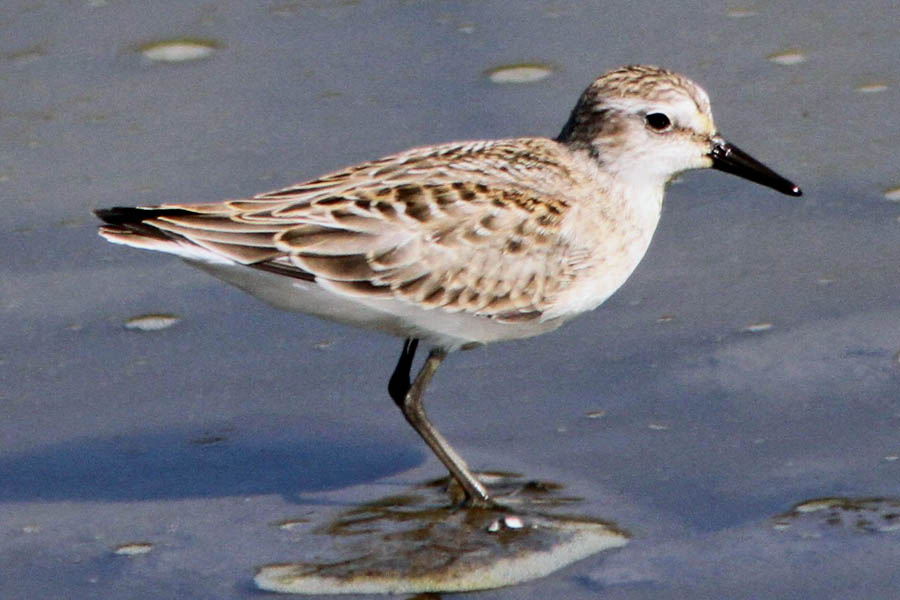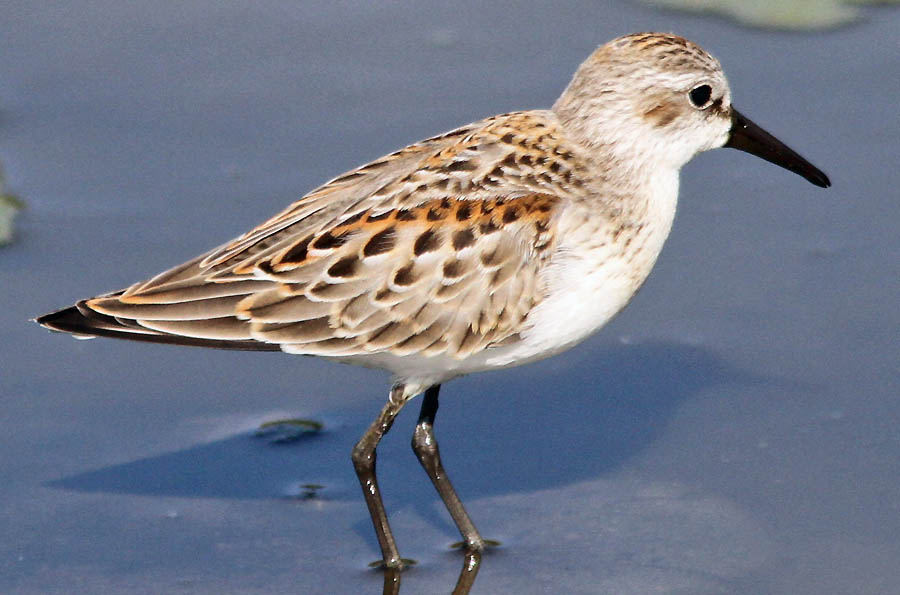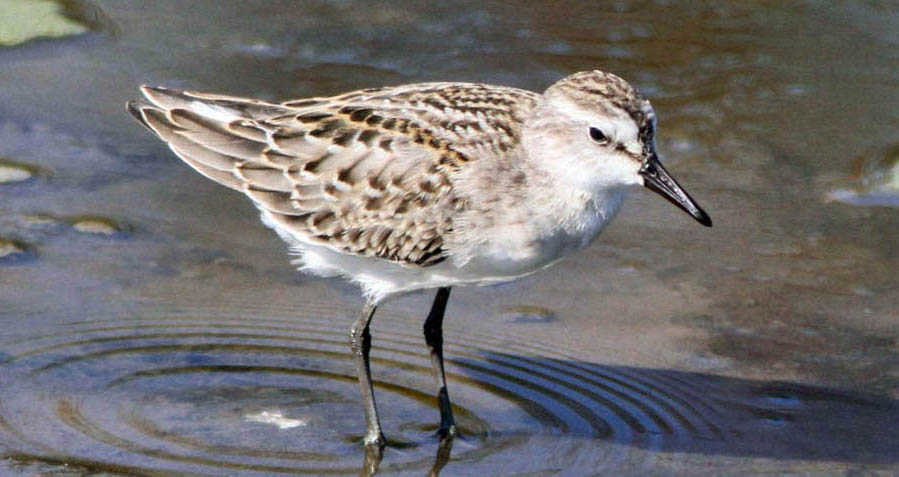| |
| Just
below is a 'classic' scaly-backed juvenal-plumaged Semipalmated
Sandpiper from Salinas WTP on 25 Aug 2014 (© Rick Fournier). This
individual was found by D. Roberson on 23 Aug 2014 among a huge flock
of Westerns, and identified by its evenly 'scaly-backed' appearance,
the short blunt-tipped bill, the 'anchor-patterned' row of lower scaps,
and the lack of 'rusty braces' formed by rufous-edged upper scaps. |
|
|
|
Above is the juvenal Calidris
found by Blake Matheson at Pt. Joe pond on 26 Aug 2014. It shows a pair
of 'rusty braces' formed by the upper scapulars that concerned me, but
the bill shape is very good for Semi, and so are the many anchor-shaped
centers of lower rows of scaps. Actually this bird made me worry about
juv Red-necked Stint (which also has anchor-shaped centers to the lower
scaps) but so far our impressions from initial review of photos is that
this individual has webbing between the toes. For the moment I am
calling it a "bright" Semipalmated Sandpiper, rather than the 'classic'
style as above. This one matches a Semi shown on plate 1 in Veit &
Jonsson (1987) Field identification of smaller sandpipers within the
genus Calidris, Am. Birds 41: 212-236.
Below
is a 'classic' juv Western Sandpiper present on Pt. Joe pond on 26 Aug
2014. Note the very red edges to the upper scaps that form the "rusty
braces" to the back, and the mostly black-centered or black
diamond-tipped centers to the lower row of scapulars, and the lack of
any truly "anchor-shaped' centers to the lower scaps. I'm not sure how
important the pattern of the centers on the lower scaps are -- since
Veit & Jonsson portray a juv Western with a pattern to the lower
scaps rather similar to what they show for Semi -- but it does appear
different in these photos. The Western also has reddish tipped tertials
and red-orange in the upper back, while the two Semis above have, at
most, a faint orangeish wash to the tip of the tertial and/or upper
back. |
|
|
The Pt. Joe bird engendered comments from two continents that it might actually be a Red-necked Stint Calidris ruficollis.
Below are comparisons of late Aug/early Sep examples of Red-necked
Stint (top), the Pt. Joe bird (two in center; one image is reversed for
comparison), and Little Stint C. minuta. Both Red-necked and
Little Stints have very thin and fine-tipped bills. In comparison the
Pt. Joe bird has a thicker, more bulbous-tipped bill. The Red-necked
bill is very short; the Little Stint is a bit longer but still thin.
Both Red-necked and Little Stint have longer wings than the Pt. Joe
bird, with 2 to 3 wingtips visible beyond the longest tertial. The Pt.
Joe bird has shorter wings, although this looks different on the left
side (which is reversed here) than the right side — and I wonder if the
Pt. Joe bird is missing a long tertial on the right side. Also the Pt.
Joe bird has longer legs than Red-necked (legs of Little are hidden).
Despite
these differences, the Red-necked Stint photographed on Gambell,
Alaska, on the very same day as the Pt. Joe bird does show a remarkable
similarity in feather patterns on the rows of scapulars. On both the
inner two rows are black-centered with rufous edges (inner row) or
rufous edges with white tips (next row outward). The outer scaps are
quite similar with pale gray centers and white tips, and there is an
"anchor" pattern within each feather formed by a dark line down the
shaft and a subterminal crescent or diamond-shaped blob.
The
Little Stint is quite different, with the outer rows of scaps all
black-centered (like the inner rows) and white (or white-and-buff)
edges. |
|
Red-necked Stint at Gambell, Alaska, 26 Aug 2014 © Paul Lehman

|
|
Pt. Joe CA 26 Aug 2014 (above; left side reversed for comparison purposes)
Pt. Joe CA 26 Aug 2014 (below; right side; both photos © D. Roberson)

|
Little Stint in U.K. on 7 Sep 2010 (© Graham Catley)
|
Of
course a feature that is not seen in these photos is the presence or
absence of webbing between the toes. Red-necked and Little Stint lack
webbing. Semipalmated and Western Sandpipers have obvious webbing. It
was my impression in the field that the Pt. Joe bird had webbing, but
the best photo I have on that point (below) is not clear. I can 'feel'
the webbing is shown by the 'big-footed' look, but it remains ambiguous.
In
the end, all reviewers agreed the Pt. Joe individual was a Semipalmated
Sandpiper, but the differences are subtle and it certainly helps to
have photo comparisons. I appreciate the reveiws and comments on this
topic from Graham Catley, Paul Lehman, Curtis Marantz, Larry Sansone,
and Brian Sullivan. It was an interesting and educational review for
me. |
|
Pt. Joe CA 26 Aug 2014 (left side shown normally; toes out of water on right foot)
|
| |
Photos: © Graham Catley, © Rick Fournier, © Paul Lehman, and © Don Roberson, as indicated, all rights reserved. |
|
|







